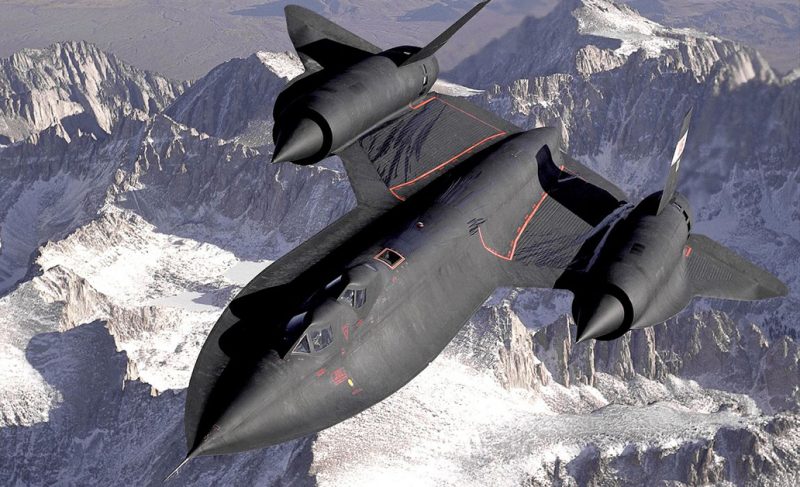On July 28, 1976, the Lockheed SR-71 Blackbird set the absolute airspeed record with a blistering speed of 3,529.6 kilometers per hour (2,193.2 mph), which is about Mach 3.3. Later that day, another Blackbird set a separate record: highest sustained altitude during horizontal flight. The Blackbird soared at 25.929 (85,069 feet) meters above sea level.
The designer of the SR-71 was Clarence “Kelly” Johnson, who worked at Lockheed’s famed Skunk Works. It was used by the US Air Force on reconnaissance missions for over 30 years. It played a key role gathering intelligence during the Cold War. On top of being able to fly higher than 85,000 feet and faster than Mach 3.2, it could survey up to 100,000 square miles in an hour. The design of the plane reduced its radar signature, and its speed was fast enough to outrun any missile fired at it.
Post-WWII, the American government, and military leaders wanted information on the Soviet Union’s nuclear missiles, ICBM program, and military installations. In the early 50s, President Eisenhower approved the use of bombers and balloons, but they were susceptible to anti-aircraft fire and fighter-interceptors. The CIA requested designs for a new aircraft that would present less of a target.
Kelly Johnson submitted the design for the U-2, which was essentially a glider with a camera underneath. It was slow and visible, but could supposedly fly high enough to be out of reach of Soviet defenses.
As a joint endeavor by the Air Force and the CIA, the U-2 flew along the border of the Soviet Union beginning in 1956 and flew 24 missions with great success. However, the design of the U-2 made it easily detectable on radar and eventually one was shot down by the Soviets. On May 1, 1960, Gary Powers was piloting a U-2 that was hit with a long range surface-to-air missile over Soviet airspace. The U.S. stopped flying over the USSR proper and began carrying out missions over areas with less capable air defenses.
Before the Powers incident, the CIA had already begun studying what characteristics a reconnaissance aircraft needed to avoid being shot down. They determined that the plane had to be supersonic and have a small radar signature. Kelly Johnson stepped up with a new design. Since the U-2 had been known as “Kelly’s Angel” or just “Angel,” Lockheed’s designs for the new plane were prefixed with an “A” for “Archangel.” The contract granted by the CIA was for the A-11, which was modified and re-designated as the A-12.
The A-12 is a single-seat, twin-engine, twin-tail design made of a titanium alloy. It has one advanced camera looking down. It was planned to add an infrared camera, radar, and a gamma spectrometer. The size was similar to the SR-71 at 100 feet long with a wingspan of 55 feet and a weight of 120,000 pounds. The CIA ordered twelve. In 1965, they began flying missions out of Kadena Air Force Base in Okinawa, Japan, as part of Operation Black Shield. They flew over Laos, North Vietnam, and North Korea.
The US Air Force was a major supporter of the CIA’s A-12 program, with major investments in money, refueling support, use of Kadena Air Force Base facilities, and transport. They realized a two-seat version of the A-12 could be useful for Strategic Air Command. The original plan was to use the planes for post-nuclear strike reconnaissance. They would fly over a site after it had been struck with nuclear armaments and gather data. As this scenario seemed less likely over time, they were outfitted with traditional reconnaissance equipment.
The Air Force knew from the A-12 program that the SR-71 would require two men, the pilot plus a Reconnaissance Systems Officer (RSO), to operate the intelligence gathering equipment and defensive systems.
The cost of operating both A-12 and SR-71 programs was prohibitive, so the SR-71 was chosen to assume the Operation Black Shield missions in 1968. It’s first operational mission was over Vietnam. They flew one to three missions per week. Flights frequently lasted over six hours and covered 7,000 square miles. They gathered images of supply depots, harbor installations, industrial complexes, and prisoner-of-war camps.
The SR-71 was used to gather information on the 1973 Yom Kippur War and the 1986 raid the U.S. conducted in Libya.
Eventually, space-based surveillance systems became sophisticated enough to take over many of the functions of the SR-71 and the more expensive Blackbird program was ended in 1989. They resumed briefly in the ’90s before coming to an end in 1998.
There are currently fifteen SR-71s remaining in museums across the country, three at Lockheed, and three kept by NASA to study aerodynamics, propulsion, structures, thermal protection, and instrumentation.
